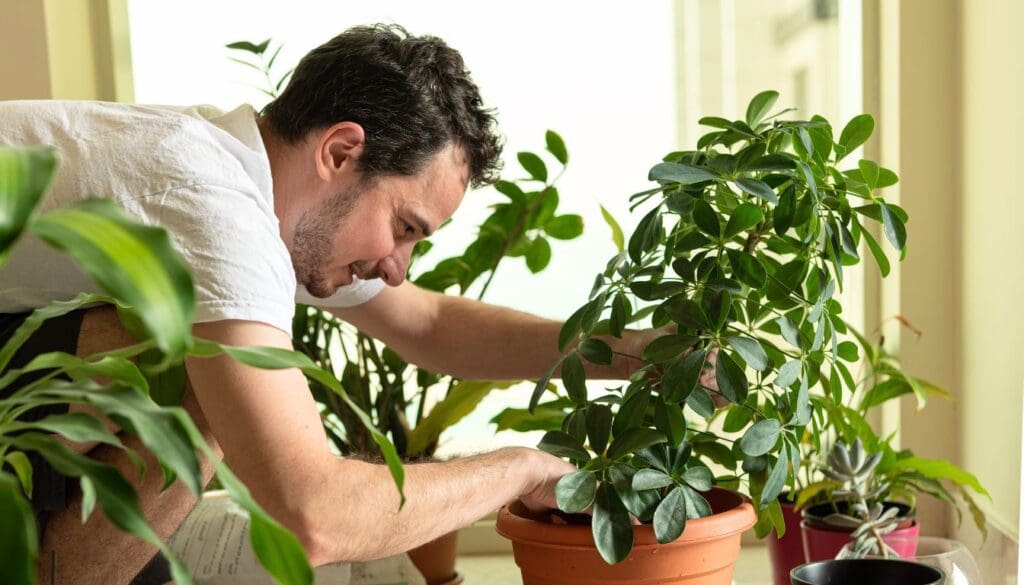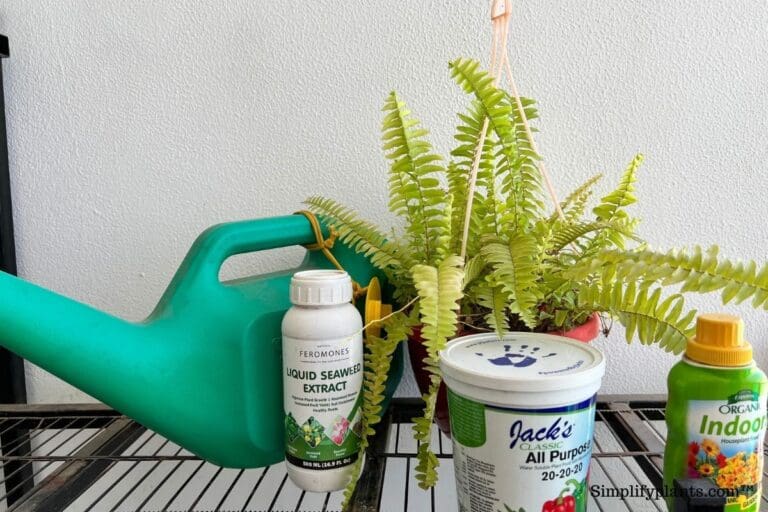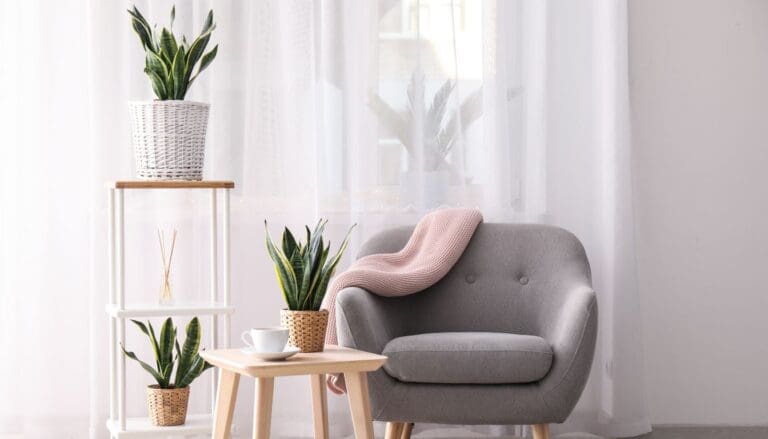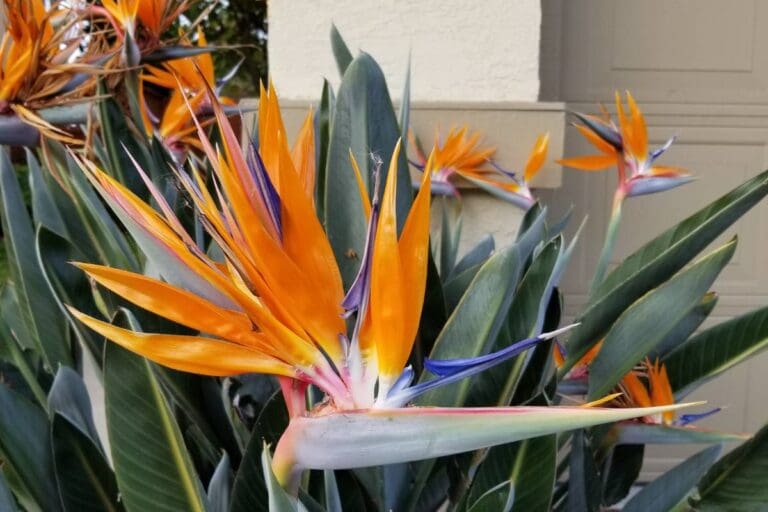6 Reasons Why Your Schefflera Is Growing Leggy
The umbrella-shaped structure of the leaves of a Schefflera plant adds a lot of elegance to any indoor space, making it a very popular houseplant for office spaces and homes. But one common problem that this plant undergoes is leggy growth.
Schefflera plants tend to grow leggy due to a lack of pruning, insufficient light, and incorrect watering techniques. You must prune the leggy parts and provide enough light, correct your watering technique, and provide the ideal growing conditions for the plant.
This article will focus on the common causes of a leggy umbrella plant and suggest solutions to fix this problem. We will also discuss ways to prevent your plant from growing leggy.

Please note: Simplify Plants is reader-supported. Some links in the post are affiliate links and I get a commission from purchases made through links in the post.
Why is my Schefflera plant leggy?
Schefflera plants have long, shiny green leaves that dangle from the central stem resembling the shape of an umbrella.
The thick leaves grow in clusters of leaf sets, exuding a bushy tropical vibe.
But due to incorrect growing conditions and internal deficiencies, this beautiful plant might start growing leggy.
Leggy Schefflera plants grow very tall and skinny, and the leaves have a lot of space between them.
The plant looks weak and uneven and lacks strength and energy.
It grows in height, but it does not grow in width, which gives it a very thin, lanky body.
Let us now learn about the causes of your Schefflera growing leggy.
Irregular pruning of the Schefflera plant
Pruning is an integral part of the care routine for any houseplant that we often tend to ignore.
Pruning the plants encourage new and fresh growth.
Irregular pruning makes the plant’s growth stagnant, and it becomes unruly and out of shape.
The stems become weaker and leggy.
The dead, yellow leaves that stay attached to the plant take away the nutrients and energy of the plant unnecessarily, which the plant could have used for pushing out new growth.
Low light conditions

Lighting conditions that a plant receives have a lot to do with the growth and health of the plants.
Plants need light because they get their food and energy from it.
Light gives them the energy to carry out photosynthesis, making food from light and water.
When the plant is kept at a spot that gets low lighting conditions than it needs, it fails to photosynthesize sufficiently, so it starts to grow taller towards the direction of the light to receive more light.
This causes the plant to grow only towards the light source, turning leggy, and the distance between the leaves increases because they grow far apart from one another in that attempt.
So keep the plant at a spot where plenty of indirect diffused light is coming in but not direct sunlight.
Also read: What Kind Of Light Does A Schefflera Need?
Temperature changes
The ideal temperature for the growth of Schefflera is 65°F to 90°F.
When the temperatures go below 50°F in an extremely cold climate, the plant starts undergoing several problems.
The extremely cold temperature can damage the molecules of the umbrella plant and hampers its natural activities like photosynthesis, respiration and transpiration, and so on.
Unstable and fluctuating temperature stresses the plant as it finds it difficult to adapt to growing conditions and causes the plant to have weak leggy growth.
You must give your Schefflera warm and steady temperatures.
Shield the plant against harsh cold winds and frost, which are extremely bad for your plant.
Also read:
- Schefflera Plant Temperature Tolerance: Ideal Temperature+Problems
- Schefflera Care In Winter: Light, Watering,& More
Incorrect fertilization

Fertilizing houseplants is important because it provides them with essential nutrients and minerals.
However, Schefflera plants are not heavy feeders, and fertilizing them too frequently or not feeding them enough can make the plant grow leggy.
Overfertilizing can also increase the plant’s growth at an abnormal rate that might cause leggy growth.
You must feed the plant during the growing season.
You can do that once in March, right at the beginning of summer, and in September, right before fall.
Be careful to maintain the quantity of the fertilizer as too much quantity can also lead to root burns and weakness in the plant.
Also read: How Often Should I Fertilize My Schefflera? (+Ideal NPK Ratio)
Wrong watering methods
Right watering is vital for every plant because it gets all the essential nutrients.
Schefflera plants like to be in slightly moist soil but hate soggy and wet soil.
Soggy soil can be dangerous because it leads to fungal diseases like root rot.
Overwatering and underwatering can weaken the plant, leading to leggy and uneven growth.
Also read: How Much Water Does A Schefflera Plant Need? (Watering Guide)
Root-bound plant
The root-bound state of the plant occurs when the roots of the plant get so big that it has no place to grow inside the pot.
The roots begin to engulf the soil as it reduces more and more.
When we water the plant in such a condition, the water fails to reach the roots and flows out.
Thus, the root-bound plant lacks essential nutrients and begins to grow limp and leggy.
When your plant grows root-bound, you must repot the plant in a 2 inches bigger pot size and the fresh potting mix.
This stimulates the growth of the plant by providing energy and nutrients.
Also read: Do Schefflera Plants Like To Be Root Bound? (+When To Repot)
How to fix my leggy Schefflera?
Now that we have studied the various causes of your umbrella plant leggy, we must understand how to fix the leggy plant.
1. Fixing leggy Schefflera not pruned correctly

Pruning is an extremely necessary part of your plant care routine, which we often neglect.
Pruning your Schefflera periodically encourages it to push more growth, keeps it in shape, and prevents unruly growth.
When the dead and yellow leaves are pruned off from the plant, it helps them from wasting their energy on keeping those leaves attached and encourages it to grow fresh leaves.
You can prune the dead leaves of plants all year round, and heavier pruning to shape it should be done in the spring and summer seasons only.
There are a few tips to remember before pruning the plant:
- Always sterilize the pruning shears before and after pruning. This prevents the spread of pathogens.
- Use sharp pruning shears to make clean cuts.
- Start pruning by trimming the yellow and brown leaves and other parts that waste the plant’s energy.
- Then proceed to prune more parts of the plant that you think are ruining the plant’s shape.
- Do not prune more than 25% of the plant at a time.
Also read: How To Prune A Schefflera Plant? (A Step-by-Step Guide)
2. Fixing a Schefflera that is leggy due to low light
Low light conditions are the most commonly found reason that leads to leggy growth in houseplants.
Ensure that you keep your Schefflera at a spot where it receives bright indirect light for at least 5-6 hours every day.
Sufficient light will help the plant photosynthesize and make food.
Keep the umbrella plant near a window that receives a lot of light or a balcony but ensure direct sunlight does not fall on the plant as that may lead to sunburn.
You can put a sheer curtain to shield it from direct light.
Low light also makes the plant grow leggy because it gets tall while growing toward the light source.
To prevent this, make sure all the sides get light evenly.
You must rotate your plant every week to make the growth even.
If you live where natural light is too low or extremely cold and gloomy, you can install artificial light for the plant.
These lights are available in most nurseries and plant shops but make sure you put the plant a few feet below the light source to protect it from the high heat.
Also read: Can Schefflera Get Too Much Sun? (Sunburn)
3. Treating leggy Schefflera due to incorrect use of fertilizer

Understanding the right fertilization schedule is important.
As we have already discussed, overuse and underuse of fertilizer can lead to leggy growth in your plant.
Changing the pot’s soil is needed if you have over-fertilized your plant.
For this, do the following:
- Take the plant out of the pot.
- Wash the roots well in clean running water.
- Examine the roots for any sign of damage.
- Prune off the dead and decayed roots.
- Trim off the leaves that have gotten yellow or burnt due to excessive fertilization.
- Prune the parts of the plant that looks leggy and tall.
- Prepare a fresh soil mix for your Schefflera. Take good quality potting soil, mix some sand, perlite, and compost with the soil. You can also add charcoal and pine bark for added aeration in the soil to keep it light.
- Take a pot of the same size of 2 inches bigger than the existing pot and repot the plant in this fresh soil.
- Water the plant after repotting and keep it at a place that receives bright indirect light.
- Do not feed the plant for 2-3 months after repotting because the soil already has compost.
If you think your plant is underfed, add good quality compost or an NPK 20-20-20 fertilizer to the soil to feed it.
But do not fertilize in dry soil and water it a day before feeding.
4. Treating a leggy Schefflera due to incorrect watering

Watering is a vital requirement for your plants that helps them produce energy and food.
Incorrect watering will make the plant grow weak and have a leggy growth.
The plant’s water requirement depends on factors like weather, location, temperature, size, etc.
You must understand the correct watering needs of the plant.
In summers, it needs more frequent watering than it needs in winters.
So never follow the same watering routine all year round.
Here is what you should do if you notice your plant has been overwatered:
- Cut down watering if you notice the soil has been staying soggy.
- Shift the plant to a place where it will receive more bright light and good airflow. These will trigger the evaporation process of the soil and help it to dry faster.
- You can add some compost to the soil to absorb the excess moisture.
- If you think the plant has started to rot due to overwatering, you prune the roots and repot it.
- In this case, remove the plant from the pot and wash the roots well.
- Prune the rotten mushy parts of the roots to prevent the spread of pathogens.
- Prepare a fresh soil mix with soil, perlite, and compost.
- Repot the plant in a new pot with a drainage hole in the fresh soil mix.
In the case of underwatering, it is easier to take care of the plant.
Let us see what you can do to fix the leggy plant due to underwatering.
- Give the plant some water and let the soil soak it up.
- After a few minutes, water it again fully until the water runs out of the drainage holes.
- Prune the leggy parts of the plant and the parts which have gotten discolored.
- Use a humidifier or pebble tray method to give your underwatered plant some humidity which would help it to bounce back.
- You can also mist your plant from time to time.
- Water the plant as and when you see the soil getting dry.
5. Fixing a leggy Schefflera due to root-bound

Root-bound plants tend to grow leggy on top because the roots have no space to expand inside the pot, so they put their energy into increasing in height without pushing out leaves or lateral branches.
The Schefflera is a medium-growing plant that needs repotting maybe after every 3-4 years.
If your plant has become root-bound, the only solution is repotting it in a bigger pot. Now let us see what steps you should follow.
- Choose a new pot that is no bigger than 2 inches. Remember, an excessively bigger pot can be harmful to the plant’s growth as that leads to overwatering issues.
- Make sure the new pot has a drainage hole at the bottom.
- Prepare an appropriate potting mix for your plant.
- Take the root-bound plant out of the pot gently. If you see it is not coming out and is stuck inside, then gently, with a knife, scrape the sides of the pot and take the plant out
- Do not be harsh with the roots as that may damage them.
- Now repot the plant in the fresh soil in the new pot.
- Once you are done, add water to the plant thoroughly until it runs off the pot.
6. Provide consistent temperature to fix the leggy Schefflera
Being a tropical plant, Schefflera likes stable mild temperatures ranging between 65°F to 90°F.
It cannot tolerate frequent disturbances in the temperature as that tends to stress the plant.
The sudden and frequent changes take up the plant’s energy to adjust itself.
Remember the following points if you try to give a steady temperature for your plant:
- Keep the plant away from heaters, air conditioners, cold draft, etc.
- In winters, do not leave your plat outside and keep them inside. Do not keep the plant too close to frosty window panes and doors where there is cold air.
- If you keep them in the same room with an air conditioner or a fireplace, keep the plant a few feet away from the source. Otherwise, they suck up moisture from the plants.
- Give your Schefflera plenty of humidity by installing a humidifier or misting, using pebble trays, or keeping it in a group with other houseplants.
- In an extremely cold climate, try to give your plant a few hours of mild morning sunlight to keep it warm.
- Measure the temperature around your plant frequently with the help of a thermometer and maintain it accordingly.
How to prevent the Schefflera plant from getting leggy?

We have discussed all the causes that might be making your plant grow leggy and suggest appropriate fixes.
Now let us quickly summarize how you can prevent leggy growth on your plant.
- Provide ample indirect bright light to your plant so that low light condition does not stress your plant.
- Prune your plant periodically during the growing season. Remember pruning will encourage it to grow more leaves and branches and keep it clean.
- Fertilize your plant in adequate quantity only during the growing season of spring and summer.
- Try to keep the temperature around your plant steady and within the ranges suitable for your plant.
- Protect the plant from extreme temperatures by bringing it indoors during cold and frost.
- Use humidifiers and pebble trays or misting to maintain the humidity level around your plant.
- Keep a check on the watering schedule of the Schefflera and alter it as per the season.
- Repot your plat every 2-3 years, depending on the growth rate.
Final words

Your Schefflera plants may get leggy due to several situations discussed above. However, you need not fret over it, as fixing this condition is easy.
Once you have identified the problem, fix the issue and prune the leggy areas of the plant to make it bounce back.
Reference: Wikipedia, Sciencedirect, Britannica, American Society for Horticultural Science, Schefflera taxonomic history.
Recommended Garden Supplies
| Product Image | Our Recommended Gardening Supplies | Check Offers! |
|---|---|---|
Top Top
Top
Top
Top
Top
Top
Top
Top | rePotme Houseplant and Tropical Classic Potting Soil Mix | Check Offer On Amazon |
 Top
Top
Top
Top
Top
Top
Top
Top | Espoma Organic Indoor Plant Food | Check Offer On Amazon |
 Top
Top
Top
Top
Top
Top
Top
Top | GooingTop LED Grow Light 6000K Full Spectrum Clip Plant Growing Lamp | Check Offer On Amazon |
 Top
Top
Top
Top
Top
Top
Top
Top | Soil Moisture Meter | Check Offer On Amazon |
 Top
Top
Top
Top
Top
Top
Top
Top | Govee Hygrometer Thermometer, Bluetooth Enabled! | Check Offer On Amazon |
 Top
Top | LEVOIT Humidifiers for Large Room(Best For Plants) | Check Offer On Amazon |
 Top
Top
Top
Top
Top
Top
Top
Top | Upgraded DIY Automatic Drip Irrigation Kit, 15 Potted Houseplants Support | Check Offer On Amazon |
 Top
Top
Top
Top
Top
Top
Top
Top | Stainless Steel Heavy Duty Gardening Tool Set | Check Offer On Amazon |
 Top
Top
Top
Top
Top
Top
Top
Top | Bonide Insecticidal Soap | Check Offer On Amazon |
 Top
Top
Top
Top
Top
Top
Top
Top | Bonide 32 oz Spray Neem Oil for Organic Gardening | Check Offer On Amazon |
 Top
Top
Top
Top
Top
Top
Top
Top | Garden Safe Fungicide | Check Offer On Amazon |






